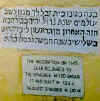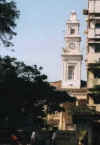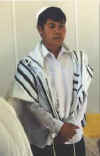|
Page 5 of 6

Jews of India - Baghdadi/Iraqi
Jews & Manipur Jews
by
Aharon Daniel
The Baghdadi Jews first arrived from Iraq, Syria, and Iran
around 1796, fleeing persecution in their
native lands and settled mainly in the port cities of Bombay, Calcutta and
Rangoon. They retained their language, Arabic, and a separate cultural
identity. Mostly traders and financiers, their contribution to the
industrial growth of Bombay is well documented. The most prominent Baghdadi
Jew was Sir David Sassoon who established the Indian House of Sassoon in
1832 and paved the way for the arrival of many other Iraqi Jews in India.
Sir David Sassoon was also a well-known philanthropist.
These communities were then set on a firm foundation by the
house of David Sassoon in the second half of the nineteenth century, and by
his grandson Jacob Eliyahu Sassoon in the early twentieth century.


Eminent in Bombay (now Mumbai) - David Sassoon
himself had to flee Baghdad in 1826 from the oppression of the Governor and
Wali of Baghdad. Starting cautiously, the Sassoon family business gained
ground and strength. With increasing wealth, the Sassoons gave huge sums to
both Jewish and public institutions. The community was set on a firm
foundation by the house of David Sassoon in the second half of the
nineteenth century, and by his grandson Jacob Eliyahu Sassoon in the early
twentieth century.
 "The
synagogues built by the Baghdadis still survive. David Sassoon built the
Magen David Synagogue in 1861 in Byculla, where the family first lived. This
was then the best location in Bombay before other areas were developed. The
large synagogue was set in extensive grounds, which were to prove very
valuable. Built in the spacious style of Victorian architecture, it was
fronted by pillars and a clock tower. David Sassoon also built an elementary
school on one side in the same large compound to provide an education for
the community's children in Torah and proper behaviour. This was later
expanded into a high school by his grandson Jacob Sassoon, and renamed
"The Sir Jacob Sassoon Free High School". The synagogue and school
grounds became in effect a community centre for the Jewish community of
Byculla, where young and old would meet together in the evenings." -
Rachel Manasseh "The
synagogues built by the Baghdadis still survive. David Sassoon built the
Magen David Synagogue in 1861 in Byculla, where the family first lived. This
was then the best location in Bombay before other areas were developed. The
large synagogue was set in extensive grounds, which were to prove very
valuable. Built in the spacious style of Victorian architecture, it was
fronted by pillars and a clock tower. David Sassoon also built an elementary
school on one side in the same large compound to provide an education for
the community's children in Torah and proper behaviour. This was later
expanded into a high school by his grandson Jacob Sassoon, and renamed
"The Sir Jacob Sassoon Free High School". The synagogue and school
grounds became in effect a community centre for the Jewish community of
Byculla, where young and old would meet together in the evenings." -
Rachel Manasseh
"The Ohel-David Synagogue was built by David Sassoon in
1863 in Poona, where he had his resort home. The synagogue is a well-known
landmark in Poona, of impressive architecture in spacious grounds in a
central location in Poona cantonment. David Sassoon's Poona home, where he
died in 1864 much mourned by Jews and Indians alike, was across the street
from the synagogue. His sons buried him in the synagogue grounds in a fine
mausoleum. The synagogue and mausoleum were visited by the President of
India, Dr. Zakir Hussein, at a special Memorial Service on 10 December 1968,
on the occasion of the Centenary celebration of the Sassoon General
Hospitals in Poona established by the Sassoons." - Rachel Manasseh
David Sassoon's grandson, Jacob Sassoon, built the Kneseth
Eliyahoo Synagogue in the Fort in 1884, in memory of his father Eliyahoo
Sassoon (founder of E.D. sassoon and Company). While very few Baghdadis now
remain in Bombay and Poona, the synagogue buildings are well maintained and
services continue to be held.
|
The Calcutta Story
Shalon Cohen, an ambitious young merchant, was one
of the first settlers to arrive in Calcutta (now Kolkata), from his
native Aleppo, in 1798. Calcutta was a flourishing centre of trade
and commerce at the time. Early Jewish settlers in Calcutta were
traders who established trading links from London to Shanghai -
dealing in indigo, cotton, yarn, silk, Veniceware, precious stones,
gold leaf, ivory and coffee. Calcutta Jewish community was set up by
Shalon Cohen and consolidated by his nephew/son-in-law Moses Duck
Cohen, who is remembered for his dedicated service to the community.
"He played a leading role in framing the first constitution of
the community (29 August 1825) and in establishing the first formal
synagogue, Neveh Shalome (Abode of Peace) in 1826, as well as first
purpose built synagogue, Bethel in Pollock Street, where it still
stands." Towards the end of the nineteenth century, the
wealthier members of the community began to adopt western dress and
etiquette. The first generations of Calcutta Jews spoke Judeo-Arabic
at home, but by the 1890s English was widely spoken. They also moved
to select residential area South of Park Street and took a prominent
part in Calcutta’s public life.
The community increased from 15 in 1799 to 200 in
1825, and in 1860 they numbered 600 and rose to 2000 by the end of
the century. "Japanese invasion of Burma (Myanmar) led to an
influx of Jews fleeing from that country raising the Jewish
population of Calcutta to an all-time high of about 5000 in early
1940."
David Joseph Ezra is associated with some of
the city’s most imposing buildings – Esplanade mansions, Ezra
mansions and Chowringhee mansions as well as Ezra street. David
Joseph Ezra made his fortune from prime real estate.
Elia David Ezra, son of David Joseph Ezra
built the city’s most magnificent synagogue - the Magen David
Synagogue.
D.J Cohen and Reverend E.M.D Cohen
played a more direct part in civic work and social uplift. Under
Reverend E.M.D Cohen’s proprietorship the Hebrew newspaper Pariah
had a circulation of 500 copies a week in 1880s.
Calcutta Jews left for Israel, England and the US,
and today only a few remain in this bustling city.
 Of
the five synagogues, only two remain open for a population of about
60 Jews: Neveh Shalome Synagogue established in 1825, the first
Synagogue in Calcutta and rebuilt in 1911, and the Magen David
Synagogue, built by Mr. Elias David Joseph Ezra to perpetuate the
memory of his father, Mr. David Joseph Ezra who died in 1882. This
is the largest Synagogue in the East and is magnificent in
architecture and design. There are still about 60 Jews in Calcutta
and all are over 65 years of age. Each week on Erev Shabbat, prayer
services are held, alternating between the Synagogues. Of
the five synagogues, only two remain open for a population of about
60 Jews: Neveh Shalome Synagogue established in 1825, the first
Synagogue in Calcutta and rebuilt in 1911, and the Magen David
Synagogue, built by Mr. Elias David Joseph Ezra to perpetuate the
memory of his father, Mr. David Joseph Ezra who died in 1882. This
is the largest Synagogue in the East and is magnificent in
architecture and design. There are still about 60 Jews in Calcutta
and all are over 65 years of age. Each week on Erev Shabbat, prayer
services are held, alternating between the Synagogues.
"The keeper of both these synagogues, the
individual who is also the keeper of the sanctum sanctorum, where
the Torahs are kept, is a Muslim. Only in India will you witness
such a level of spiritual neighborliness between two religions which
seem to optimize violence to us, living in the West."
|
MANIPUR JEWS - Bne Menashe


Manipur Jews or the Bne Menashe maybe one of
the lost tribes.
In east India in the States of Manipur and Mizoram exists a
community which sees itself as descendants of the Menashe Tribe (one of the
10 lost tribes). These people claim that
after their forefathers were exiled and enslaved by the Assyrians they
somehow escaped from slavery and arrived in China. Later on they moved to
the Chinese-Burmese border and much later on to the neighbouring east India.
Most of the residents of Mizoram and Manipur are Christians. Among the
Manipur Jews there are some who believe that all the Manipur and Mizoram
residents (about 2 million people) are originally from the Menashe tribe.
The Manipur Jews believe that the Christian missionaries in the 19th century
forced them to abolish their Jewish identity and adopt Christianity.
1951 onwards, after a local chief, named Tchalah revealed to
his people that God had told him that his people should return to their
original religion and land (Judaism and Israel), there has been a movement
to return to Judaism and immigration to Israel. Some of the Israeli rabbis
accept their Judaism and others don’t see them as original Jews. Many of
the immigrating Manipuri Jews to Israel have converted to Judaism through
strict Jewish laws.
___________________________
Page 6 (Community Information)
Acknowledgements
Disclaimer |






